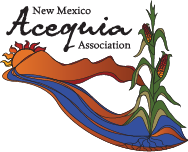
By Paula Garcia, Executive Director
New Mexico's arid environment has fostered a worldview of reverence for water for millennia among the indigenous people of the area who have practiced sophisticated water harvesting and floor irrigation methods. When acequias were established with the settlement of mexicano and mestizo pobladores, the landscape was further transformed with the extension of networks of irrigation works that supported arable lands for food production.
Survival of communities depended on a culture of interdependence and sharing. For centuries, acequias have looked to the sierra before Spring in anticipation of snowmelt that would create the flows in streams and rivers that would flow into acequias and eventually to fields and crops. Since every year was different, acequias had to learn how to share limited water in real time. They had to rely on generational memory and observation to estimate the flow of rivers and streams. And when Spring was upon them, they had to decide among themselves how to share the water as fairly and equitably as possible. After generation upon generation, these arrangements became the customs and traditions of the acequias. In many communities, these customs continue and are sometimes called the "reparto" or "repartimiento."
A custom is an agreement among people that is carried on by oral tradition, practice, or both. It depends on having a common set of values and a common understanding. Customs are not easily enforced by a higher authority; they depend on a level of agreement about a common need or resource. In the case of water sharing, customs are based on a shared belief in equity and mutual respect. Some examples of a water sharing custom are those that are practiced within acequias. For example, some acequias highly encourage parciantes to keep family gardens by setting aside a time just for gardens. An acequia may allow all family gardens to be irrigated daily in the early morning. That same acequia may allocate other times for irrigating pasture on a rotation between parciantes in which water is allocated in units of time, or tiempos, depending on the extent of their derechos, or water rights. Each and every acequia is different and the customs for water sharing depend on history, crop patterns, and community relationships.
Additionally, many communities have customs that guide the sharing of water between acequias that share the same stream. There are several historical examples of acequias developing agreements with the goal of equitably sharing limited water on a shared stream system. In some cases, acequias made written agreements on water allocation indicating that sometimes more formality was needed to settle disagreements. One very recent example of water sharing in times of drought was in Embudo where acequia leaders held frequent meetings to come to an agreement about a rotation that would allow one acequia to irrigate at a time along the Rio Embudo.
Customs are agreements made at a local level by the people most affected by those decisions. They have the potential to efficiently and equitably distribute scarce water as part of a community-based management system. For local communities, the most important task is to work together to come to a common understanding of local customs which may be based on historical practice, current conditions, or both. It is preferable for acequias to be self-determined about these decisions rather than to ask the courts or the State Engineer to decide for them. As we start the Spring, it is very important for acequias to be prepared for water shortages with a good method to communicate with parciantes and a common understanding of customs to share scarce water.


Leave a Reply